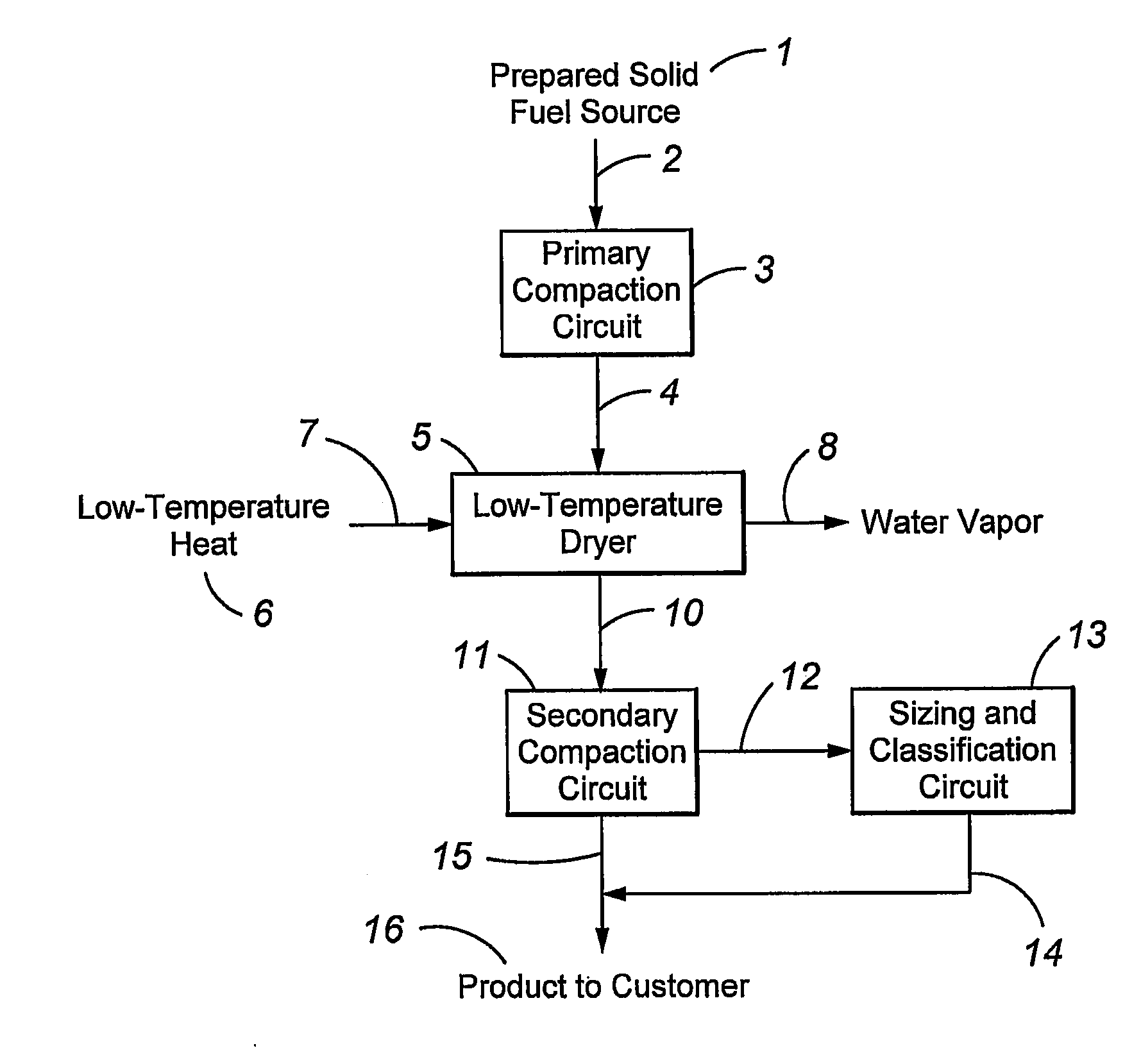Methods of Producing Water-Resistant Solid Fuels
- Summary
- Abstract
- Description
- Claims
- Application Information
AI Technical Summary
Benefits of technology
Problems solved by technology
Method used
Image
Examples
example 1
[0038]One low rank coal (high-moisture lignite from North Dakota) was studied to assess the effects of preparing a high-solids concentration slurry. Results of these investigations are listed in Tables 1-3.
[0039]A sample of raw North Dakota lignite was crushed to pass 5 mm screen openings. The raw material, containing about 36 wt % moisture, was deslimed at 0.5 mm, treated with warm 35-g / l sulfuric acid for 1 hr, and compacted in a roll press set at 5 t / cm roll width closing force. The resulting ribbon of compacted coal was air dried at ambient conditions (about 24° C., 30% relative humidity) to a moisture level of about 20 wt %. The partially dried ribbon was compacted a second time, and air-dried to about 16 wt % moisture content. This process was repeated to achieve a moisture content of 14 wt %, 10 wt %, and 7 wt %.
[0040]The final compacted product was crushed by hand in a mortar and pestle to pass 12 mesh. The minus 12-mesh product was dry screened at various mesh sizes, the pr...
example 2
[0044]A sample of North Dakota Lignite was deslimed at 35 mesh to remove high-ash sand and clay, and immersed in 35 g / l concentration sulfuric acid for 1 hr at 37° C. The treated product was rinsed and mechanically dewatered. The dewatered product was compacted and dried by the methodology of the present invention.
[0045]The compacted product was crushed and screened into size fractions. Each size fraction was assayed for total moisture content, and then immersed in distilled water held at ambient temperature (about 24° C.). The water absorption rate was measured at various time intervals. The total water contained in the immersed solids was computed by adding the water held in the sample at the start of the test with the water absorbed during immersion. The heating value of the immersed compacted material was calculated based on total moisture content and the moisture-ash-free calorific value of the material. The results are listed in Table 5, and the values for each size fraction a...
example 3
[0047]A sample of Indonesian lignite was compacted and dried as taught by the present invention. Acid treatment or desliming treatments were not required for this sample because of low ash content of this lignite feed material.
[0048]The compacted product was crushed and screened into size fractions. Each size fraction was assayed for total moisture content, and then immersed in distilled water held at ambient temperature (about 24° C.). The water absorption rate was measured at various time intervals. The total water contained in the immersed solids was computed by adding the water held in the sample at the start of the test with the water absorbed during immersion. The heating value of the immersed material was calculated based on total moisture content and the moisture-ash-free calorific value of the material. The results are listed in Table 6 and the values for each size fraction are plotted in FIG. 6.
[0049]Commercial slurry operations maintain slurry in holding tanks between 4 a...
PUM
 Login to View More
Login to View More Abstract
Description
Claims
Application Information
 Login to View More
Login to View More - R&D
- Intellectual Property
- Life Sciences
- Materials
- Tech Scout
- Unparalleled Data Quality
- Higher Quality Content
- 60% Fewer Hallucinations
Browse by: Latest US Patents, China's latest patents, Technical Efficacy Thesaurus, Application Domain, Technology Topic, Popular Technical Reports.
© 2025 PatSnap. All rights reserved.Legal|Privacy policy|Modern Slavery Act Transparency Statement|Sitemap|About US| Contact US: help@patsnap.com



